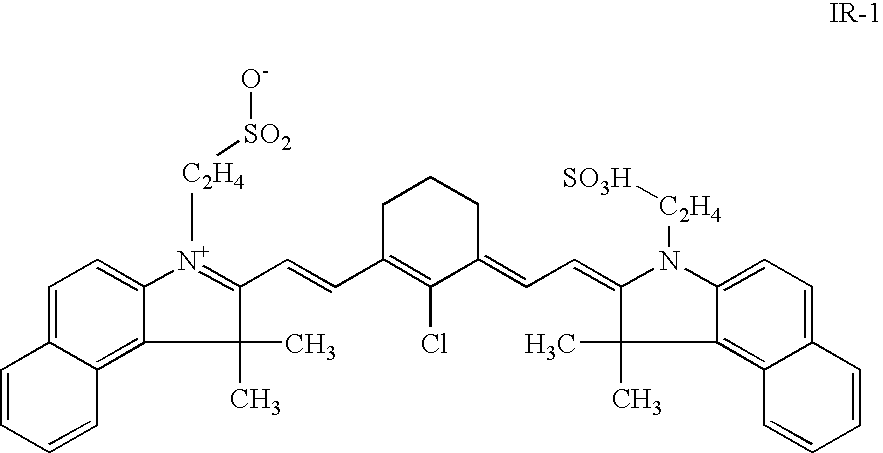Method for making a lithographic printing plate
a lithographic printing plate and negative printing technology, applied in the field of negative printing plate and heat-sensitive lithographic printing plate, can solve the problems of high sensitivity, high run-length during printing, and long exposure time and/or high-power laser, and achieve complete and profound removal (i.e. clean out) of non-exposed areas, improve sensitivity, and improve press life
- Summary
- Abstract
- Description
- Claims
- Application Information
AI Technical Summary
Benefits of technology
Problems solved by technology
Method used
Image
Examples
invention examples 2 and 3
[0061] The printing plate precursor 1 prepared as described in Comparative Example 1 was processed in an Agfa VA88 processor, operating at a speed of 1 m / min and at 23° C., using a phosphate buffer (Invention Example 2, Table 3) or a silicate buffer (Invention Example 3, Table 4). After development, the plates were gummed with RC795 (trademark from Agfa).
[0062] The occurrence of stain on the obtained printing plates was determined (Dmin).
TABLE 3developer solution comprising a phosphate bufferDeveloperPHDminNaH2PO4 + NaOH to pH:9.990.143NaH2PO4 + NaOH to pH:110.098NaH2PO4 + NaOH to pH:11.990.059
[0063] The data in Table 3 indicate that the pH of the developer solution comprising a phosphate buffer has a large effect on stain (Dmin). A Dmin value of Dmin<0,1 defined as no stain is obtained at a pH of 11 or higher.
TABLE 4developer solution comprising a silicate bufferDeveloperpHDmin 1 ml / l Potassiummetasilicate10.660.156 5 ml / l Potassiummetasilicate11.810.08320 ml / l Potassiummetasi...
example 4
Preparation of the Lithographic Substrate.
[0065] A 0.30 mm thick aluminum foil was degreased by immersing the foil in an aqueous solution containing 40 g / l of sodium hydroxide at 60° C. for 8 seconds and rinsed with demineralized water for 2 seconds. The foil was then electrochemically grained during 15 seconds using an alternating current in an aqueous solution containing 12 g / l of hydrochloric acid and 38 g / l of aluminum sulfate (18-hydrate) at a temperature of 33° C. and a current density of 130 A / dm2. After rinsing with demineralized water for 2 seconds, the aluminum foil was then desmutted by etching with an aqueous solution containing 155 g / l of sulfuric acid at 70° C. for 4 seconds and rinsed with demineralized water at 25° C. for 2 seconds. The foil was subsequently subjected to anodic oxidation during 13 seconds in an aqueous solution containing 155 g / l of sulfuric acid at a temperature of 45° C. and a current density of 22 A / dm2, then washed with demineralized water for ...
example 5
Preparation of the Lithographic Substrate.
[0075] The preparation of the lithographic substrate was done according to Example 4.
Preparation of the Printing Plate Precursors 8-11.
[0076] The printing plate precursors 8 to 11 were produced by applying a coating onto the above described lithographic substrate. The composition of the coating is defined in Table 7. The average particle sizes of the styrene / acrylonitrile copolymers were measured with a Brookhaven BI-90 analyzer, commercially available from Brookhaven Instrument Company, Holtsville, N.Y., USA, and are indicated in Table 8. The coating was applied from an aqueous coating solution and a dry coating weight of 0.84 g / m2 was obtained.
TABLE 7composition of the dry coating(% wt)INGREDIENTS% wtStyrene / acrylonitrile copolymer(1)83Triethylammonium salt of IR-1(2)8Polyacrylic acid binder(3)6Cab O Jet 250(4)3
(1) weight ratio 60 / 40, stabilized with an anionic wetting agent; particle size as defined in Table 8;
(2) infrared absorbi...
PUM
| Property | Measurement | Unit |
|---|---|---|
| particle size | aaaaa | aaaaa |
| particle size | aaaaa | aaaaa |
| particle size | aaaaa | aaaaa |
Abstract
Description
Claims
Application Information
 Login to View More
Login to View More - R&D
- Intellectual Property
- Life Sciences
- Materials
- Tech Scout
- Unparalleled Data Quality
- Higher Quality Content
- 60% Fewer Hallucinations
Browse by: Latest US Patents, China's latest patents, Technical Efficacy Thesaurus, Application Domain, Technology Topic, Popular Technical Reports.
© 2025 PatSnap. All rights reserved.Legal|Privacy policy|Modern Slavery Act Transparency Statement|Sitemap|About US| Contact US: help@patsnap.com

